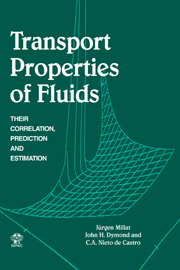Book contents
- Frontmatter
- Contents
- List of contributors
- Foreword
- Part one GENERAL
- Part two THEORY
- Part three DATA REPRESENTATION
- Part four APPLICATION OF SELECTED METHODS
- 9 Computer Calculation
- 10 Modified Hard–Spheres Scheme
- 11 The Corresponding–States Principle: Dilute Gases
- 12 The Corresponding–States Principle: Dense Fluids
- 13 Empirical Estimation
- Part five APPLICATION TO SELECTED SUBSTANCES
- Part six DATA BANKS AND PREDICTION PACKAGES
- Index
12 - The Corresponding–States Principle: Dense Fluids
Published online by Cambridge University Press: 07 October 2009
- Frontmatter
- Contents
- List of contributors
- Foreword
- Part one GENERAL
- Part two THEORY
- Part three DATA REPRESENTATION
- Part four APPLICATION OF SELECTED METHODS
- 9 Computer Calculation
- 10 Modified Hard–Spheres Scheme
- 11 The Corresponding–States Principle: Dilute Gases
- 12 The Corresponding–States Principle: Dense Fluids
- 13 Empirical Estimation
- Part five APPLICATION TO SELECTED SUBSTANCES
- Part six DATA BANKS AND PREDICTION PACKAGES
- Index
Summary
Introduction
The power and versatility of corresponding–states (CS) methods as a prediction tool has been pointed out by Mason and Uribe in Chapter 11 of this volume. Here, however, the strong point of corresponding–states principles is stressed: that methods based on the principle are theoretically based and predictive, rather than empirical and correlative. Thus, while CS cannot always reproduce a set of data within its experimental accuracy, as can an empirical correlation, it should be able to represent data to a reasonable degree but, more important, do what a correlation cannot do – estimate the properties beyond the range of existing data. In this chapter a particular corresponding–states method is reviewed that can predict the viscosity and thermal conductivity of pure fluids and their mixtures over the entire phase range from the dilute gas to the dense liquid with a minimum number of parameters. The method was proposed several years ago by Hanley (1976) and also by Mo & Gubbins (1974, 1976). It led to a computer program known as TRAPP (‘TRAnsport Properties Prediction’ (Ely & Hanley 1981a)). The method is also the basis for two NIST Standard Reference Databases – NIST Standard Reference Database 4 (SUPERTRAPP; Ely & Huber 1990) and NIST Standard Reference Database 14 (DDMIX; Friend 1992). Here, the original TRAPP procedure will be discussed as well as some more recent modifications to it. The performance of the model for viscosity and thermal conductivity prediction will also be examined for selected pure fluids and mixtures.
- Type
- Chapter
- Information
- Transport Properties of FluidsTheir Correlation, Prediction and Estimation, pp. 283 - 295Publisher: Cambridge University PressPrint publication year: 1996
- 24
- Cited by

